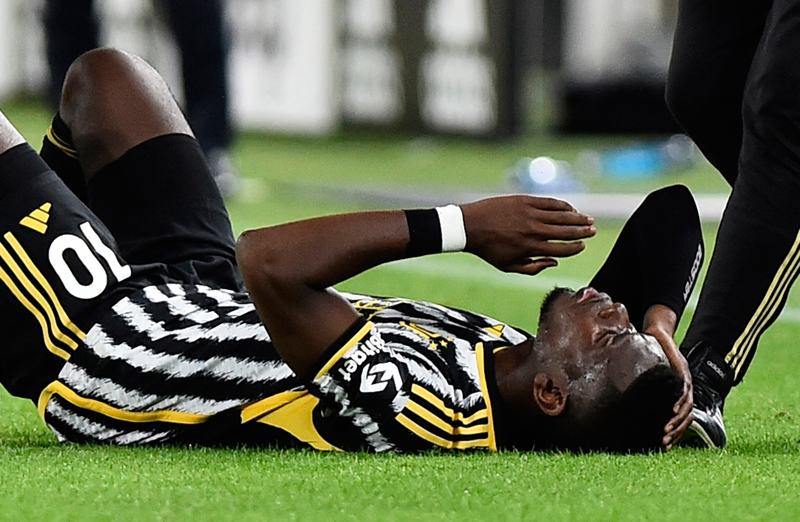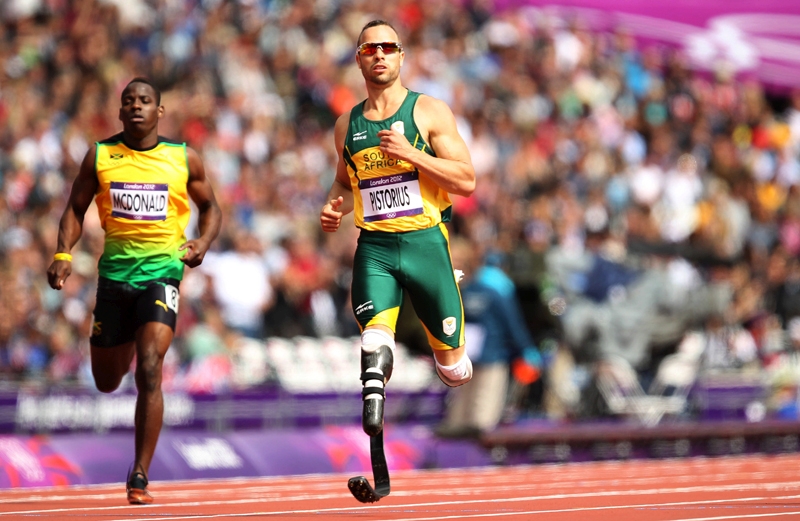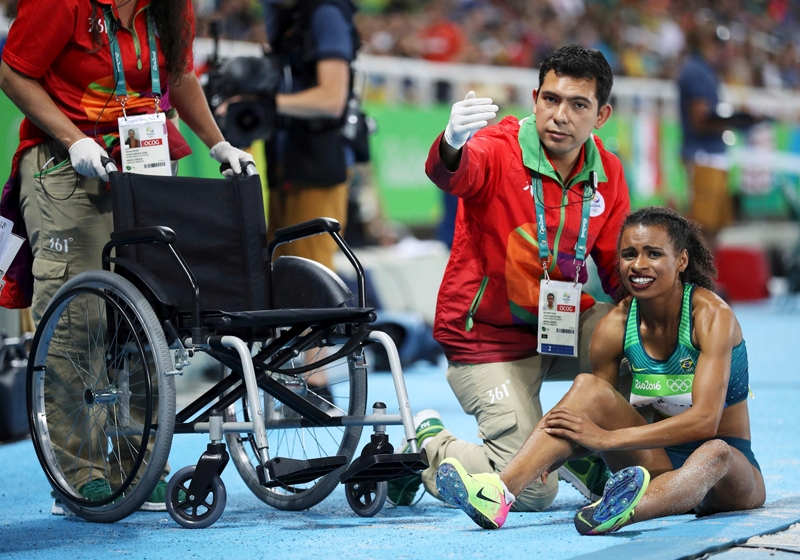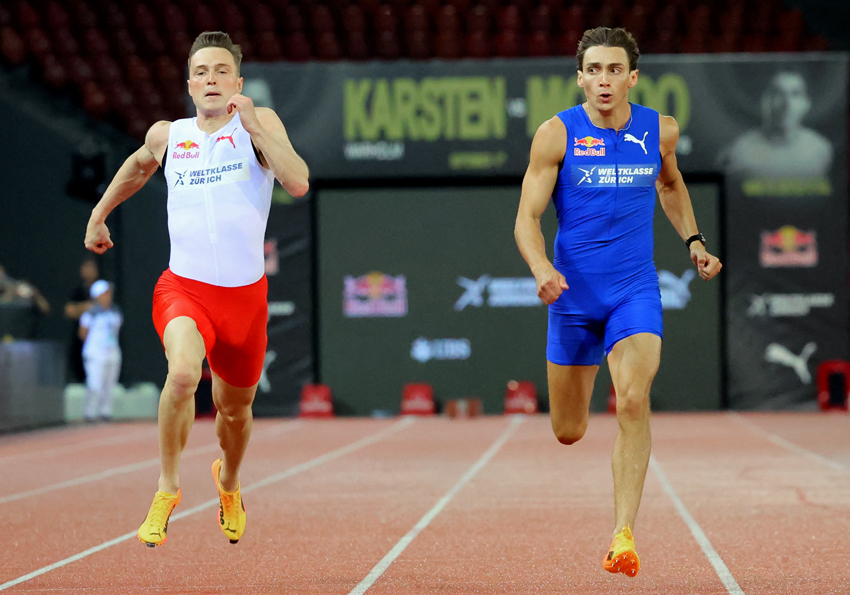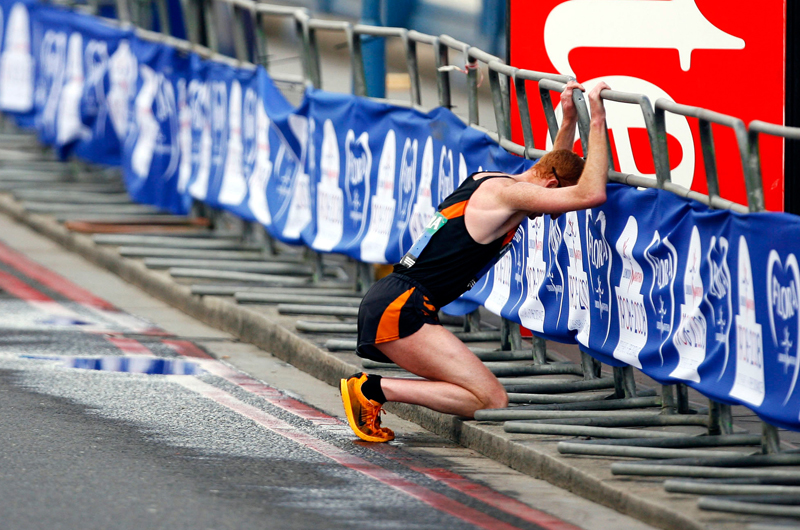No fear! Ensuring a successful return to sport after injury
Returning to training and competing after a long layoff can be an anxious experience. Adam Nicholls provides you with a number of psychological strategies to make your return to sport much less daunting
Sport scholars from the University of Toronto have defined an injury as ‘any occasion in which medical attention is required during a competition or a training session’. An injury stops you from participating in sport or training for at least one day, but some injuries, such as an anterior crucial ligament injury to the knee may stop you competing for up nine months.
As such, sustaining an injury can be a very traumatic experience for an athlete, especially if he or she requires surgery and/ or a long period of rehabilitation, which results in a pro-longed absence from sport. Much attention is given to help the injured part of an athlete’s body, but the health of the mind is often neglected during the period of injury and when the athlete returns to sport. This means that some athletes struggle when they resume training and competition, because they are not psychologically ready.
What happens when you are close to resuming training?
This can vary from person to person, and is dependent on a multitude of factors, such as the personality of the athlete, the type of injury sustained, the psychological and physical trauma when the injury occurred, and the length of time an athlete is away from his or her sport.
However, for some endurance athletes, returning to sport will provoke anxiety. It is important to note that we can feel anxious when there is uncertainty about what may happen in the future. This could relate to performance or doubts about whether the injured body part will be strong enough after rehabilitation. Experiencing anxiety is unpleasant and may result in athletes focusing on negative ‘what ifs’ such as:
- What if I break down again?
- What if I can’t get back to my previous level of performance?
- What if I get a compensation injury?
- What if I have to go through another lengthy rehabilitation again?
Some athletes can become completely pre-occupied with negative thoughts when they are close to returning to training and competition. In order to help overcome these negative thoughts, there are a number of physical strategies (in addition to psychological strategies) that you can employ whilst injured. These are detailed in the case study of mountain runner, Mary Wilkinson (see below).
CASE STUDY: Mary Wilkinson and tips for physical conditioning
 Mary Wilkinson is a former Great Britain international endurance athlete, who now focuses on mountain running. She has competed in races all over the world, and some of her notable results include finishing 4th in the World Trophy in New Zealand and 4th in the European mountain championships - despite suffering many injuries. Indeed, in the lead up to the European championships, Mary suffered a variety of injuries and illnesses, which stopped her from running for five months before competing in these championships. How did she achieve such impressive results? Mary explains her process, using a number of steps which involvewww.inov-8.com/blog/cross-training-for-injured-runners/:
Mary Wilkinson is a former Great Britain international endurance athlete, who now focuses on mountain running. She has competed in races all over the world, and some of her notable results include finishing 4th in the World Trophy in New Zealand and 4th in the European mountain championships - despite suffering many injuries. Indeed, in the lead up to the European championships, Mary suffered a variety of injuries and illnesses, which stopped her from running for five months before competing in these championships. How did she achieve such impressive results? Mary explains her process, using a number of steps which involvewww.inov-8.com/blog/cross-training-for-injured-runners/:
- Identifying pain free exercises
- Making a plan
- Maintaining strength and conditioning
- Not fearing intensity
- Feeding the competitor in you
Identifying pain free exercises - After receiving you’ve received an injury diagnosis, ask you physiotherapist or doctor, what you are able to do. In the build up to the European championships, Mary did a variety of low-impact activities, such as swimming, cycling, rowing, and used equipment such as a stepper and cross trainer. Mary’s favourite exercise was aqua-jogging, which involves wearing a buoyant belt around the waist, so you can run upright in the water with your feet touching the surface of the swimming pool floor.
Making a plan - Even though she was injured, Mary planned training activities, and varied between aqua jogging, running, and cycling. Indeed, Mary believed that it was the variation in training activities that kept her motivated.
Maintaining strength & conditioning - In addition to rehabilitation exercises, Mary also worked on areas of weakness, such improving her core strength and glute (buttock muscle) function. She also bouts of did high-intensity interval training (20 seconds of maximal effort with 10 seconds of recovery), which helped Mary maintain conditioning.
Not fearing intensity - When engaging in other forms of exercise whilst injured, some people may be scared of exercising intensely. As long as the exercise is pain free, you can exercise at high intensity levels, to maintain fitness levels. Mary was a strong advocate of this approach.
Feeding the competitor in you - Even though Mary could not run, she still had urges to compete, so entered cycling races. As such, you could enter competitions, as long you can engage in your chosen exercise pain free.
Are you psychologically ready?
Even though you may have been given the all-clear to resume training, you might not be mentally ready. You can complete an adapted version of the ‘Injury-Psychological Readiness to Return to Sport Scale’J Ath Train, 44, 185–189, 2009. This was created by scholars from Springfield College and allows athletes to measure their confidence in returning to sport (see table 1).
Answer the following questions by rating your confidence to return to sport by circling the appropriate number, and then adding up your score.
Table 1 An adapted version of the Injury Psychological Readiness to Return to Sport Scale
| Questions | No confidence in my return to sport | Moderate confidence in my return to sport | Complete confidence in my return to sport |
|---|---|---|---|
| 1. My overall confidence to play my sport is: | 0 | 50 | 100 |
| 2. My confidence to play my sport without any pain is: | 0 | 50 | 100 |
| 3. My confidence to be able to give 100% effort is: | 0 | 50 | 100 |
| 4. My confidence to not think about the injury when playing is: | 0 | 50 | 100 |
| 5. My confidence in the injured part of my body to be able to handle to demands of playing again is: | 0 | 50 | 100 |
| 6. My confidence in my skill level is: | 0 | 50 | 100 |
| #colspan# | TOTAL SCORE |
Your total score will range between 0 and 600. Scholars from Springfield College suggested that athletes who score between 500 and 600 are ready to return to their sport. Athletes who score less than 500 are not psychologically ready. If you scored less than 500, there are strategies you can employ to improve your psychological readiness, which are explained in the remainder of the article. Even if you scored over 500, you still may benefit from employing such strategies, in order increase your psychological readiness to return.
Enhancing your psychological readiness Researchers from the University of Utah examined factors that enhanced an athlete’s psychological readiness to return to sport (see Figure 1)The Sport Psychol, 29, 1-14, 2015.
Figure 1: Precursors of psychological readiness

Confidence in returning to sport
Athletes who were psychologically ready to return to their sport spoke about having confidence that they could make a successful return. This confidence came from three main sources:
(a) Trusting the knowledge of the medical team. If you are injured it is important that you trust the expertise of the medical team around you (ie surgeon, physiotherapist, or conditioning coach etc) and the decisions they are making on your behalf. This will help give you confidence from the treatment you have received. If you do not trust your medical team, it is important that you find a new team that you can trust!
(b) Social support from physiotherapists and/or coaches. Athletes developed their confidence by listening to positive feedback from their physiotherapist or coach during the rehabilitation period, especially if setbacks occurredPhys Ther Sport, 13, 35–40, 2012. It is important that you listen to your physiotherapist or coach, and accept any praise or positive feedback that they give you. It is easy not fully acknowledge praise, especially if you believe that your progress is poor. However, trust that your physiotherapist has the experience when they provide positive feedback regarding your progress. Do not doubt any praise that you receive. Write down each piece of positive feedback you receive in diary and regularly look at these entries.
(c) Achievement of physical standards during rehabilitation. Athletes’ attainment of physical standards such as muscular strength or endurance and achieving progress in such standards is a source of confidence. If you are injured, set yourself some short-term goals and allow yourself to feel happy and excited when you achieve these goals. Do not feel too despondent when you do not achieve your goals though, because it is normal for there to be setbacks along the way.
Realistic expectations
It is important that when you return to sport, you have realistic expectations about your own capabilities. Indeed, athletes reported being more psychologically ready to return their sport if they were patient regarding when they could return to competition and had a realistic expectation of their performance when they first returned to sport. If you are injured, it is therefore important that you do not try and rush your recovery. It is inevitable that you will want to return as quickly as you can. But be realistic and listen to the timeframes set out by your medical team. This will help ensure that you are mentally ready when you return to competition. Accept that time away from your sport may have impacted upon your performance. It is important to have a realistic understanding of what you will (and will not) be able to do before you return to your sport. This will result in you not being too disappointed (see box 1).
Previous performance standards
The scholars from the University of Utah also found that motivation can be enhanced by engaging in key strategiesThe Sport Psychol, 29, 1-14, 2015:
(a) Effective goal setting. As alluded to previously, goal setting can be a source of confidence. Setting yourself challenging, but attainable goals can also be a source of motivation. For example, you could set yourself the ultimate goal of wanting to surpass your pre-injury performance level, if this is realistic. Before that however, you would need to set yourself a range of short and medium-term goals that will help you achieve this ultimate goal.
(b) Boredom. Athletes reported being bored during their rehabilitation. This was caused by having to repeat many of the same exercises. Some of the athletes used this as motivation – ie it helped them to want to return to their sport and to get past the rehabilitation phase.
(c) Feeling wanted by others. When playing sport - especially in team sports - there is sense of collective togetherness with players due to these players spending a lot of time together. When injured, athletes can feel isolated. If you know another athlete who is injured at the same time, try and arrange your rehab sessions so that they are at the same time and you can spend time with each other and even help each other out.
Finally, researchers from the University of Hull have found that particular behaviours during rehabilitation influence an athlete’s psychological readiness when he or she returns to sportPhys Ther Sport, 13, 35–40, 2012. These include:
Staying involved with your club - As previously mentioned, being injured can result in athletes feeling very isolated, which can lead to feelings of depression and anxiety. This isolation can occur because the athlete is no longer involved in training sessions or matches. However, to prevent this isolation from occurring, it is important that you stay involved with your club. You can do this by offering to volunteer as a steward at races or take on administrative duties. Staying involved will also help prevent a fear of re-injury occurring when you return to competing. It may also give you a fresh insight for when you return to sport.
Staying in the game - Even though you are injured, it is likely that you will have amassed knowledge in your sport, which could benefit other people. You can use this knowledge constructively by offering to coaching sessions, such as running sessions for junior athletes.
Be patient!
Even though a cross-training regime as advocated by Mary Wilkinson will help you maintain fitness levels, she still found that it took time to get used to the impacts of running. As such, Mary gradually incorporated and then slowly increased the amount of running within her training sessions. As she increased running volumes, she decreased cross training correspondingly.
However, Mary knew that she had to be patient, because she did not want to cause another injury through over training. As such, she started by running for 30 seconds on five occasions with a 30 second break, and slowly increased this to 2 minutes of running with a break, and then to five minutes and so on. You can do the same too; slowly increase the amount of time you spend running, but only do this if you are pain free. Remember not to rush this phase, because it could result in you re-injuring your body part or sustaining a compensatory injury (ie when another part of your body is injured because it is compensating for the injured body part). Adhering to these guidelines will help you make a successful return to sport.
Summary
Injuries are a common occurrence in sport endurance sports such as running, especially if you push yourself to the limit to achieve your goals. In order to ensure that you are mentally prepared to return to your sport after an injury, it is important that you address the psychological side of your rehabilitation. In order to be ready, trust the medical team around you and the advice they provide, accept positive feedback from your medical team, be patient and don’t rush your recovery. Set yourselves some goals, understand that your performance might take a while to return to pre-injury levels, stay involved with your club, and maintain your conditioning by engaging in low impact activities.
Newsletter Sign Up
Testimonials
Dr. Alexandra Fandetti-Robin, Back & Body Chiropractic
Elspeth Cowell MSCh DpodM SRCh HCPC reg
William Hunter, Nuffield Health
Newsletter Sign Up
Coaches Testimonials
Dr. Alexandra Fandetti-Robin, Back & Body Chiropractic
Elspeth Cowell MSCh DpodM SRCh HCPC reg
William Hunter, Nuffield Health
Keep up with latest sports science research and apply it to maximize performance
Today you have the chance to join a group of athletes, and sports coaches/trainers who all have something special in common...
They use the latest research to improve performance for themselves and their clients - both athletes and sports teams - with help from global specialists in the fields of sports science, sports medicine and sports psychology.
They do this by reading Sports Performance Bulletin, an easy-to-digest but serious-minded journal dedicated to high performance sports. SPB offers a wealth of information and insight into the latest research, in an easily-accessible and understood format, along with a wealth of practical recommendations.
*includes 3 coaching manuals
Get Inspired
All the latest techniques and approaches
Sports Performance Bulletin helps dedicated endurance athletes improve their performance. Sense-checking the latest sports science research, and sourcing evidence and case studies to support findings, Sports Performance Bulletin turns proven insights into easily digestible practical advice. Supporting athletes, coaches and professionals who wish to ensure their guidance and programmes are kept right up to date and based on credible science.
